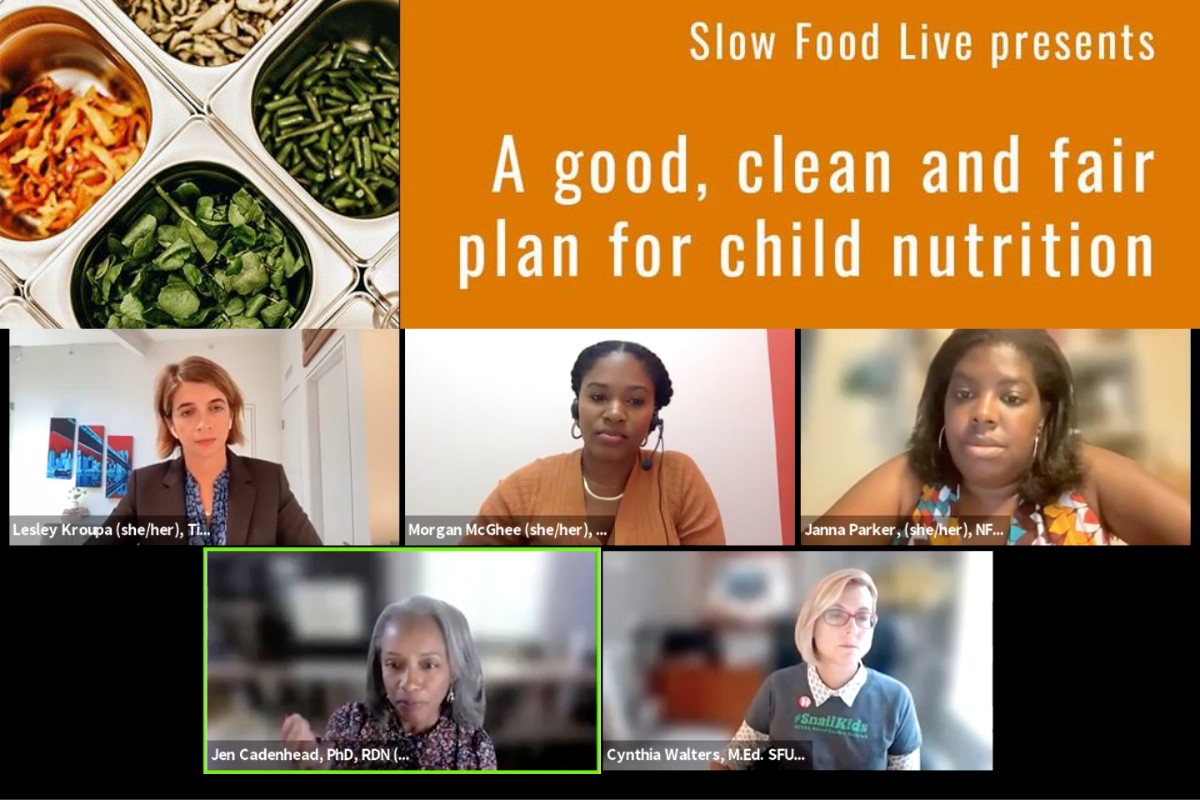On Sept 22nd, Lesley Kroupa, JD, MS, RD, the Tisch Food Center’s Interim Policy Director, and Jen Cadenhead, PhD, RD, the Goldberg Postdoctoral Researcher in Food Trauma in Children at the Tisch Food Center, were invited to a panel curated by the Slow Food USA’s Food and Farm Policy team. The focus of the webinar was to learn the ins and outs of the child nutrition reauthorization (“CNR”) process and to explore ways to advocate for equitable child nutrition programs. Major themes of the discussion included: farm-to-school programming, nutrition education, and school kitchen equipment upgrades.
As moderator, Lesley began with a brief history of CNR and highlighted the urgent need to support policies related to child nutrition programs. While CNR may sound like a bill, it is actually the process that authorizes all federal child nutrition programs (“CNP”) (e.g. the National School Lunch Program and the Summer Food Service Program). The CNR process typically occurs every 5 years. The current iteration of CNR - the Healthy, Hunger-Free Kids Act of 2010 - expired on September 30, 2015. However, CNP programs have continued to operate with temporary extensions despite delayed reauthorization. A number of programs related to child nutrition are being negotiated as part of the current federal fiscal year 2022 budget reconciliation process, however, CNR is expected to take place in early 2022. Additionally, Lesley noted that there are a number of recently introduced marker bills that relate to CNP, including the: Food and Nutrition Education in Schools Act, Farm to School Act of 2021, Kids Eat Local Act, and School Food Modernization Act.
Cadenhead and the other panelists, Janna Parker, Policy Associate, National Farm to School Network, and Morgan McGhee, Director of School Nutrition Leadership, FoodCorps, shared great insights during the discussion. When asked about the importance of nutrition education in the school setting, Janna emphasized the importance of culturally responsive nutrition education, which helps students understand that healthy eating can look different in different populations. Janna also pointed out how nutrition education in schools encourages healthy eating patterns to be adopted beyond the school setting among parents, communities, and even future generations.
Regarding recently proposed provisions contained in the Build Back Better Act, that would provide funding as part of the budget reconciliation process for nutrition education and school kitchen infrastructure upgrades, Morgan specified how such funding is essential to ensure that fresh and local food is provided to students. Dr. Cadenhead noted that some resource-poor schools cannot afford skilled chefs and food service workers to cook more scratch-based meals with fresh produce for students, thus necessitating increased investment in child nutrition and the need to think more broadly about addressing the reliance on packaged and processed foods in school cafeterias.
Discussion of another marker bill, the Farm to School Act of 2021, highlighted the issue of food procurement and the purchasing power of school districts. Janna pointed out that connecting schools and local farmers not only changes the eating habits of students, but strengthens the sense of community by helping students understand where their food comes from and encouraging them to give back to their community. Cultural and regional responsiveness, explains Janna, is enhanced through farm to School programs and thus helps build economic justice and racial equity, two of the National Farm to School Network’s six shared community values.
Ending remarks from Cynthia Walters, Slow Food USA, were a call to action for us all to contact our elected representatives at the local, state, and federal level as well as our local school wellness committees to advocate for healthy and sustainable meals for all children. She noted that while it is sometimes easy to get discouraged in this pursuit, she draws inspiration from the many foodservice champions working with children every day to provide kids with nourishing meals. She concluded by sharing a quote that she displays in her classroom to inspire her and others to continue to advocate for school meals, which says: “If you want to change the world, don’t do it with sadness, but do it with joy.” Our voices really can make a difference in supporting robust child nutrition programs.
A link to this and other webinars by Slow Food USA can be found on the Slow Food Live website.
